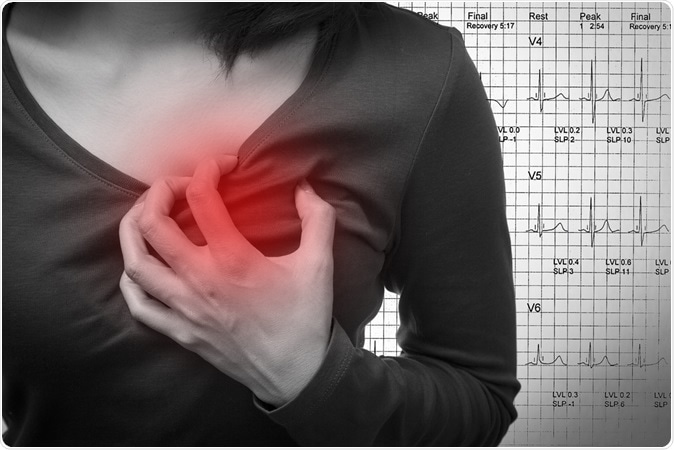A new study has shown that symptoms of heart attack may often be missed among women aged 55 years or less as these symptoms may be less common than the traditional chest pains. The study reveals that over half of the physicians who attend to these women may miss the symptoms to be caused by heart attacks before these women are eventually hospitalized. Missing the key signals of a heart attack could mean that women of this age group are more at risk of dying from it compared to men of the same age group, the study authors state.

Image Credit: Theerapol Pongkangsananan / Shutterstock
The study results were published in the latest issue of the journal Circulation (19th of February 2018). The study data was obtained from the “Variation in Recovery: Role of Gender on Outcomes of Young AMI Patients (VIRGO) study” that involved several institutions.
The study shows that most men and women experience chest pains as part of their heart attack symptoms. However women may be experiencing certain symptoms beyond chest pains. These are the symptoms that may or may not be associated with chest pains that can be misinterpreted until vital time has passed. Judith Lichtman, associate professor in the Department of Chronic disease Epidemiology at Yale School of Public Health and lead author of the study explained that background for this study was that young women aged between 18 and 55 years are at a greater risk of death due to heart attacks compared to men of the same age group.
Another contemporary study that was published in the Journal of American College of Cardiology looked at heart attack related in-hospital deaths between 2001 and 2010. They noted that in-hospital death rates of women in this age group was between 2.3 percent and 3.3 percent whereas among men the chances of in-hospital deaths was between 1.8 percent and 2 percent.
For this latest study the team of researchers looked at 2009 women and 976 men. They were all aged between 18 and 55 years and were all hospitalized for having symptoms of heart attack between August 2008 and January 2012. A total of 103 hospitals across US were included in the survey.
After the heart attack and initial care the patients were all interviewed. They were asked if they had sought for any medical attention the week prior to the attack. These symptoms during the week before the attack were recorded and they were asked if their health care providers had told them that the symptoms were related to an impending heart attack. Results revealed that 22.1 percent of the men and 29.5 percent of the women had seen a medical professional for symptoms over the week leading to the attack. Of these 37 percent of the men and 53 percent of them were told that their symptoms were not due to a heart attack or an impending heart attack. Lichtman calls these “missed opportunities” that could help identify heart attacks earlier. The population, she explained, were all at risk of heart disease with background conditions such as diabetes, obesity, stroke, kidney conditions, lung conditions, heart failure etc. being higher among women than men.
They found that majority of the participants had complained of chest pain (87 percent men and 89.5 percent women). Most women complained that their chest pain was too bad to ignore when they sought help. Lichtman said that it was not always chest pain per se but some complained of chest discomfort, tightness or pressure. These descriptions were more common among women she said. Women had three or more non-chest pain related symptoms in 69.1 percent of cases compared to 54.8 percent among men. Some of these included neck pain, feeling that the bra was too tight when it wasn’t, shortness of breath, palpitations etc.
According to Litchman, the study mainly relies upon self-reports by the patients who may be viewing their symptoms prior to the attack with more bias. That may be one of the problems with interpreting the results of this study. Further many of the deaths due to heart attacks on the way to the hospital had to be excluded from the study because the patients could not be interviewed.
Timely interventions for heart attacks is vital to save lives. Not treating a heart attack leads to abnormal heart rhythms or arrhythmias that can sometimes be fatal or may lead to heart failure and death. A heart attack occurs once in every 40 seconds in the United States and once in every seven minutes in the United Kingdom according to the statistics from the Centers for Disease Control and Prevention (CDC) and charity Heart UK respectively. The World Health Organization (WHO) calls coronary heart disease and related deaths to be the leading cause of deaths worldwide. Among so many deaths, many may be prevented with timely intervention.